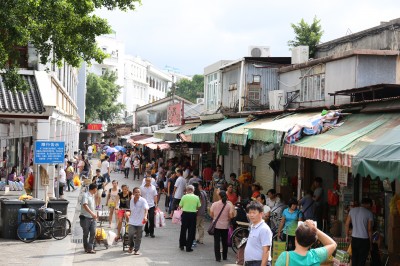Sha Tau Kok residents disagree over whether closed area should be opened up
By Brian Wong and Sherry Tsui
The two sides of Chung Ying Street are lined with boutiques selling clothes and knick-knacks and stores selling everything from accessories to electronics and appliances. But the most popular ones are the grocery shops and minimarts offering everyday consumer items imported into Hong Kong – such as milk powder, instant noodles, nappies and shampoo. Shoppers enter empty-handed and leave with boxes of goods. Outside the stores, people busily pack the goods they have bought.

They are free to shop on both sides of the 250-metre-long street, and pay no attention to the seven boundary stones separating Hong Kong and mainland China in the middle of Chung Ying Street. They were erected in 1898 to mark the boundary between imperial China and British Hong Kong, and after 1950 between the People’s Republic of China and the capitalist crown colony.
In 1951, most areas of the Sha Tau Kok district became part of the Frontier Closed Areas (FCA), including Chung Ying Street, which means visitors can only enter with a permit. Today, the Sha Tau Kok Rural Committee estimates that only 6,000 to 7,000 of the 30,000 or so residents from Sha Tau Kok’s 47 villages still live in the area, of which 4,000 to 5,000 are non-indigenous residents.
At the urging of the Rural Committees, the government announced a substantial reduction of Hong Kong’s Frontier Closed Area in 2008. Currently, Sha Tau Kok Market and Chung Ying Street are the only restricted areas left in Hong Kong and ironically access is easier from the mainland side where travel agents can secure permits for Rmb10.
Business may be brisk now, but it cannot compare with the early 1980s when China embarked on economic reform and Mainlanders flocked to Chung Ying Street to buy Hong Kong and foreign goods. At its peak during the 1990s, there were more than 40 gold shops in Chung Ying Street – the businesses there attracted up to 100,000 visitors and made HK$1 billion in takings a day. The adjacent Sha Tau Kok Market also prospered at that time.
Tsang Yuk-on, the indigenous village representative of Mui Tsz Lam Tsuen, says mainland residents and Sha Tau Kok residents could go freely between Chung Ying Street and Sha Tau Kok Market before 1997 as the colonial government exercised discretion over their movements. But after the handover, the permit system was strictly enforced on the Hong Kong side. Tsang speculates this is due to the need to enforce the One Country, Two Systems principle.
He is disappointed to see many of the spaces and facilities in Sha Tau Kok Market left unused after access became restricted. “For 16 years, we’ve wasted the shop spaces. The whole area is wasted,” Tsang says. It is hard to make a living in the closed area and he estimates that fewer than a thousand people stay overnight as most residents have moved to the mainland side or the downtown areas in Hong Kong where there is better transportation and access. Tsang says many hold on to their empty homes solely so they can apply for permits to enter the closed area.
Tsang and other indigenous villagers think the only way to stem the exodus and revive the area is to open it up and develop it.
Members of the Sha Tau Kok District Rural Committee and Sheung Shui District Rural Committee submitted a development plan to the Development Bureau and Security Bureau in February this year. Proposals include setting up a boundary control point at Chung Ying Street and opening up Sha Tau Kok Market. They say development of Sha Tau Kok could curb the number of mainland visitors going further afield to shopping hubs like Sheung Shui and Tsim Sha Tsui.







































